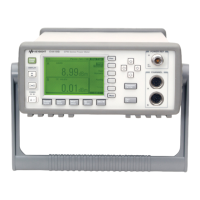4-14 Chapter 4
Making GSM Air Interface Measurements
Making the Transmitter Transmit (Tx) Band Spurious Measurement
Making the Transmitter Transmit (Tx) Band
Spurious Measurement
Purpose
The transmit band spurious measurement checks a transmitter’s
transmit band for conformance to the ETSI specification: (see Table 4-3
below).
NOTE Although the Idle Mode parameter has no effect when testing in BTS
mode, the parameter should always be set to the relevant setting (Idle
Mode = ON or OFF) so that the measurement knows which limit to use.
Measurement Method
The measurement splits the transmit band into four segments (or less if
the currently selected ARFCN is at the edge of the band) and allocates
analyzer parameters for each segment.
Two measurement modes are provided:
• Full: Each segment is swept and the peak trace point amplitude and
frequency stored. The maximum of these peaks is taken as the worst
spur and checked against a user definable limit parameter to see
whether or not the spur fails the test.
• Examine: A single full measurement is performed, the measurement
then parking on the segment containing the worst spur.
NOTE If the measurement is set to sweep mode single, or if the measurement
mode is examine, you can examine each segment individually using the
View menu keys.
Making the Measurement
1. Press the
Measure key.
Table 4-3 ETSI Specification: Maximum Permissible Measured
Power (dBm)
GSM
450
GSM
480
GSM
850
P-GSM
900
E-GSM
900
R-GSM
900
DCS
1800
PCS
1900
MS (idle) –57.0 –57.0 –57.0 –59.0 –59.0 –59.0 –53.0 –53.0
MS
(active)
–36.0 –36.0 –36.0 –36.0 –36.0 –42.0 –36.0 36.0
BTS –36.0 –36.0 –36.0 –36.0 –36.0 –36.0 –36.0 36.0

